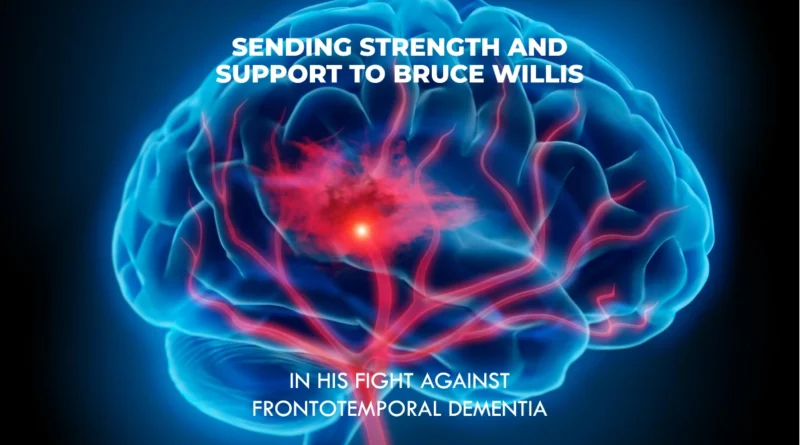Bruce Willis’ Battle with Frontotemporal Dementia: A Courageous Journey
In the world of Hollywood, few names shine as brightly as Bruce Willis. Known for his iconic roles in action-packed blockbusters like “Die Hard” and “Pulp Fiction,” Willis has captured the hearts of audiences worldwide with his charismatic presence. However, in recent times, a different spotlight has been cast upon him – one that reveals a personal and courageous battle with frontotemporal dementia (FTD).
Understanding Frontotemporal Dementia (FTD)
Before delving into Bruce Willis’ journey, let’s understand what frontotemporal dementia is. FTD is a progressive neurological disorder that primarily affects behavior, language, and executive function. It’s a complex condition that can manifest in various ways, making it challenging not only for the individual but also for their loved ones.
The Three Subtypes of FTD
FTD is categorized into three subtypes, each with its distinct set of symptoms:
- Behavioral Variant Frontotemporal Dementia (bvFTD): This subtype often results in changes in personality, social conduct, and emotional regulation. Individuals may exhibit inappropriate behaviors or apathy.
- Semantic Variant Primary Progressive Aphasia (svPPA): In svPPA, language difficulties take center stage. People with this subtype struggle with understanding and using words, leading to communication challenges.
- Nonfluent Variant Primary Progressive Aphasia (nfvPPA): As the name suggests, nfvPPA primarily affects speech production. Individuals may struggle to articulate words and form sentences fluently.
Bruce Willis’ Diagnosis
In 2022, Bruce Willis’ health issues first made headlines. However, it wasn’t until 2023 that his family officially revealed his diagnosis of FTD. This revelation came less than a year after announcing his initial diagnosis of aphasia, a condition that affects a person’s ability to communicate.
Bruce’s wife, Emma Heming Willis, has been a pillar of strength during this challenging period. She has openly shared her experiences as a spousal caregiver, offering insights into the difficulties of caring for someone with FTD.
Emma’s Journey as a Caregiver
Emma Heming Willis’ journey as a caregiver for her husband has been marked by love, resilience, and compassion. In a heartfelt Instagram video, she tearfully opened up about the daily struggles of caring for Bruce, shedding light on the emotional toll that comes with witnessing a loved one’s cognitive decline.
Bruce Willis’ Health Timeline
| Year | Milestone |
| 2022 | Reports of health issues |
| 2023 | Official diagnosis of Frontotemporal Dementia (FTD) |
| 2023 | Emma Heming Willis’ candid caregiving video |
The Impact of FTD on Bruce Willis
FTD has affected Bruce Willis in ways that extend beyond the physical. While he may be best known for his tough-guy roles on the silver screen, this battle has revealed a different kind of strength – the resilience of the human spirit.
The Complexities of Frontotemporal Dementia
Frontotemporal dementia is a complex condition, and its impact can vary from person to person. Some common symptoms include:
- Personality changes
- Social disinhibition
- Language difficulties
- Emotional blunting
- Executive dysfunction
These symptoms can challenge not only the individual but also their caregivers and loved ones.
Common Symptoms of Frontotemporal Dementia
| Symptom | Description |
| Personality changes | Altered behaviors, preferences, and interests. |
| Social disinhibition | Reduced social norms and inhibition, leading to inappropriate actions. |
| Language difficulties | Struggles with understanding and using words. |
| Emotional blunting | Reduced emotional responses and empathy. |
| Executive dysfunction | Impaired cognitive abilities related to planning, decision-making, and organization. |
The Importance of Caregiver Support
Caring for a loved one with FTD is an emotionally and physically demanding role. Emma Heming Willis’ openness about her caregiving journey highlights the importance of caregiver support.
Table 3: Tips for Caregivers of Individuals with FTD
| Tip | Description |
| Seek support from support groups | Connecting with others facing similar challenges can provide emotional support and guidance. |
| Educate yourself about FTD | Understanding the condition can help caregivers anticipate challenges and plan for care. |
| Consider respite care | Taking breaks and caring for your own well-being is crucial for providing effective care. |
| Maintain open communication | Effective communication is key to managing behavioral changes and ensuring the person’s comfort. |
Conclusion
Bruce Willis’ journey with frontotemporal dementia is a poignant reminder of the challenges many individuals and their families face when dealing with neurological disorders. Emma Heming Willis’ unwavering support and willingness to share her experiences as a caregiver have shed light on the complexities of FTD and the importance of caregiver support.
As we celebrate Bruce Willis’ illustrious career on the big screen, let us also celebrate his strength in the face of adversity. FTD may be a formidable opponent, but with love, understanding, and support, individuals like Bruce Willis continue to inspire us all.
References:
- Los Angeles Times – Emma Heming Willis shares how she copes with Bruce Willis’ dementia
- Global News – Bruce Willis’ wife gives tearful update amid his dementia
- Oprah Daily – Emma Heming Willis Shares Struggles After Bruce Willis’ Health Diagnosis
- The AFTD – Willis Family Statement
We hope this blog provides valuable insights into Bruce Willis’ journey and the challenges of dealing with frontotemporal dementia.




